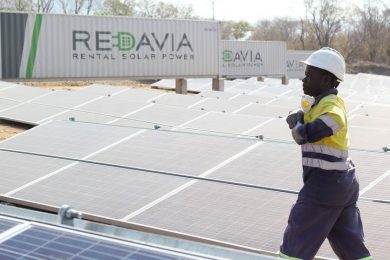Power for remote mines is a topic of the January issue (with extra distribution at Africa’s most important mining exhibition and conference – Mining Indaba in Cape Town. For decades, the off-grid African mining industry has depended largely on diesel fuel to power operations. But seemingly every day, as sure as the sun rises, solar energy and other renewable power sources have been making big impacts. Yet, companies and communities are still hesitant to adopt solar energy.
Redavia asks why and notes that “Technological advancements coupled with human ingenuity have led renewable energy sources to go from a dream state to modern reality. In particular, solar energy farms have made incredible strides in technology, implementation and cost-effectiveness.
“Today, solar energy is a tried-and-tested, efficient and economic energy resource. It powers homes, businesses, universities and communities. As the costs of solar power have fallen rapidly below those of conventional electricity fuels, new opportunities have risen for intelligent solar-hybrid systems.
“Nowhere more than in sub-Saharan Africa is solar energy poised to make such a long-lasting impact. Businesses and communities, whether located far from power grids or powered by an unreliable grid still lack efficient energy to power everyday lives. Solar energy meets these demands, both in terms of economics and efficiency.
“In sub-Saharan Africa, off-grid mines regularly rely on expensive power from diesel generators to power continuous 24/7 operations. With the implementation of solar energy, however, mines can create a reliable hybrid energy system that reduces diesel fuel consumption, increases financial efficiency and establishes environmental responsibility. With reliable power, mines can run at constant high levels and provide workers with additional services, such as lodging, reliably.”
Shanta Gold opened its Luika gold mine in Tanzania in 2012. For its first few years of operation, it relied exclusively on diesel fuel to generate the electricity to power its operations. At that time, diesel-only was the optimal energy source, but things have changed since then. Because of the fluctuating price of diesel, Shanta had to make critical decisions regarding its energy.
Shanta also wanted its energy supply to be lowest cost, being forward-thinking, and eco-conscious. The company examined the alternatives and quickly turned its attention to the many possibilities of renewable energy. After exhaustive research and planning, it settled on solar energy for its practicality and efficiency.
Shanta worked with Redavia on an initial solar plant to get a glimpse of the possibilities. There are many solar energy suppliers, but the company says its “business model is uniquely appealing to businesses such as mines. Instead of manufacturing and selling solar farms to clients, Redavia provides rental solar farms mainly to remote businesses and communities that face many challenges in maintaining efficient and economic energy. These solar farms are preconfigured and shipped in standard ISO containers, allowing for set-up to happen over the course of a few days or weeks.
“In comparison to independent power producers, which typically demand 15-20 year, fixed power purchase agreements, Redavia’s redeployable solar farms enable shorter off-take contracts that offer greater operational flexibility for customers. In addition, the rental approach, provides customers with more consistent system quality, faster delivery and simpler regulatory processes.”
For Shanta, Redavia deployed a 63 kWp initial rental solar power plant directly to the mine, combined it with the existing diesel generator setup, and created a powerful hybrid system. Throughout the entire process, Redavia and Shanta closely collaborated to collect valuable site-specific data, implement strategies and ensure complete operation.
Shanta soon began achieving the benefits of a rental solar farm, including immediate cash savings with no up-front investment. Going further, the solar plant generated around 100,000 kWh in the first year with an estimated fuel saving of 28,000 litres and CO2 reduction of 67 t.
After implementing a highly efficient solar plant providing consistent and cost-effective energy, Shanta began executing its expansion plan, taking its operations underground. Without hesitation, Shanta chose to install additional seven Redavia solar farm containers to help provide the extra power. With eight solar farm containers operational in total, Shanta is set to save approximately 219,000 litres of fuel and achieve an estimated CO2 saving of ~660 t/y.










